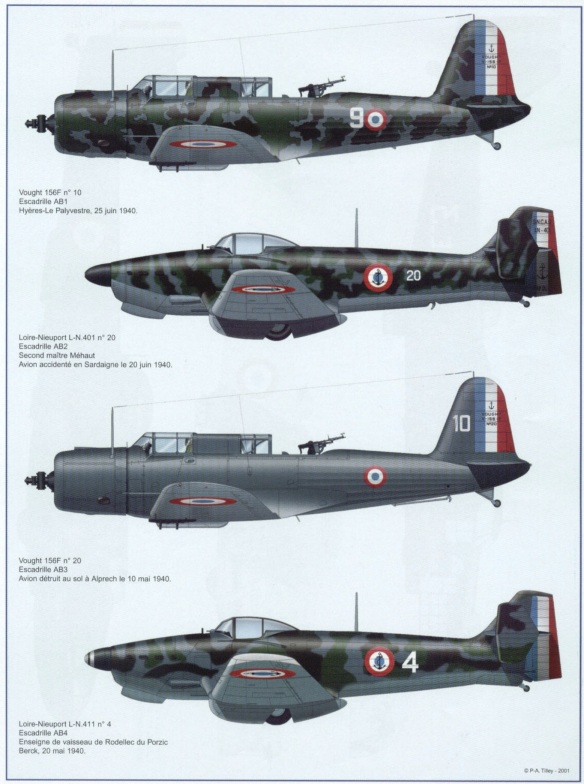Development of carrier fighters for the French Navy followed a very distinctive course. The first type embarked on the Béarn in early 1928 was the Lévy-Biche LB2. This wooden biplane had a detachable undercarriage, a boat-shaped lower fuselage, and small floats under the lower wings to allow it safely to alight on water in an emergency. Its 300-horsepower Hispano-Suiza 8Se engine gave it a top speed of 135 miles per hour. It was replaced late in 1928 by the Dewoitine D. 1, a parasol-winged monoplane with an all-metal structure and a monocoque fuselage. With an engine similar to that powering the LB2, it attained 140 miles per hour and had a range of 250 miles. In 1931 another parasol-winged all-metal monoplane replaced the D. 1. The Wibault 74’s corrugated metal stressed skin produced a strong, light, and relatively durable structure. Using a 420- horsepower Gnome-Rhone 9Ady radial engine, its performance was almost identical to its precursor’s, but had the advantage of a much superior rate of climb and greater structural strength. The final French carrier fighter to enter service before World War II was yet another parasol-winged design. L’Aeronavale accepted two versions of Dewoitine’s D. 37 fighter, the D. 373 with fixed wings and the D. 376 with folding wings, in 1938. These aircraft were of all-metal stressed-skin construction, and their powerful 930-horsepower Gnome-Rhone 14Kfs radial engines gave them a top speed of 255 miles per hour and a range of 560 miles. Their engines, however, were unreliable and low-wing monoplanes clearly offered greater performance potential. Consequently, the French Navy ordered an export version of Grumman’s F4F-3 to replace its Dewoitines, but these Grumman Model G-36A aircraft were not delivered before France fell in June 1940 and instead served with the Royal Navy.
The French Navy also came to appreciate the potential of dive bombing. Unsuccessful trials of the prototype Loire-Nieuport LN. 140 in 1936 delayed adoption of dive bombers until just after war had begun in Europe, when the same firm’s LN. 40 entered service, albeit operating from land bases as the Béarn was occupied in transporting aircraft from the United States. It had a 690-horsepower Hispano-Suiza 12Xcrs liquid-cooled engine, giving it a top speed of 238 miles per hour and a range of 750 miles with a 550-pound bomb. As a stopgap the French Navy turned to Vought’s successful SB2U instead. The Vought V-156-F, differentiated mainly from United States Navy equivalent models by its dive brakes, was just entering service as World War II began.
The French Navy after World War I maintained a dozen or more front-line land-based aviation units in metropolitan France and North Africa, seaplane units spread throughout the French Empire, and embarked aircraft aboard battleships, cruisers, seaplane carriers, and its sole aircraft carrier, the Béarn. The majority of its pilots and observers were commissioned officers, graduates of the Naval Academy at Brest, who received flight training and anticipated professional naval careers. Aspiring enlisted aircrew also received specialized training. In general, aircrew tended to remain within their specialized fields (fighters, reconnaissance, etc.) throughout their flying careers. There were some uncertainties, since naval aviation was a relatively small part of the navy and its survival was always subject to political influences.
Naval aviators, both officers and enlisted men, underwent initial flying orientation prior to beginning specialized training at the base d’aéronautique navale (BAN) Rochefort. Successful graduates then proceeded to basic flying training, officers to BAN Fréjus-Saint Raphael (1919-1922), then to BAN Istres or BAN Rochefort (1923-1930), and enlisted pilots to BAN Istres. All those who successfully completed basic flying training and who opted for carrier service then completed advanced training at BAN Fréjus-SaintRaphael. Other aircrew (non-pilots) underwent training at BAN Hourtin as observers, bombardiers, or air-gunners. In 1931 the navy merged its training system with that of l’Aviation Militaire (which became l’Armée de l’Air in 1933). Basic flying orientation took place at Versailles, with flying training at either Villacoublay or Avord, though non-pilots continued to train at BAN Hourtin. In 1933 the government transferred the bulk of the navy’s land-based units, both aircraft and personnel, to l’Armée de l’Air. Consequently, these units retained a strong naval flavor for some years afterwards and some of their members reverted to naval service when the navy was able to reestablish shore-based units in 1938. Furthermore, the French Navy never established a clear career path for its aviation officers.
